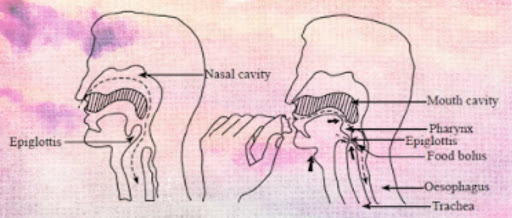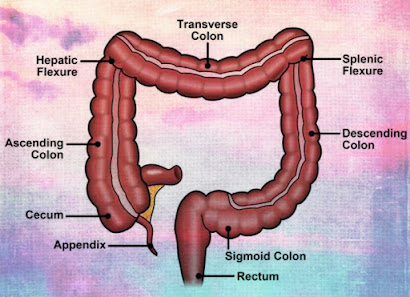Process of food Digestion
Energy is required for different biological processes that take place in human body. Energy is obtained through food that we take into the body. These food contain nutrients such as carbohydrates, lipids and proteins. Carbohydrates, lipids and proteins are complex organic molecules that do not dissolve in water. These compounds cannot be absorbed into the human body. Therefore they should be broken down into small particles.
The process by which the complex organic compounds are converted into simple organic products to be absorbed into the human body is called digestion of food.
Food digestion takes place in two process namely mechanical and chemical processes
1. During mechanical process the physical nature of the food is altered,
E.g. :- Breaking down of food into small pieces by teeth inside mouth.
2.During chemical process, the insoluble complex compounds are broken down into simple molecules by the action of enzymes.
E.g. :- Starch is converted into maltose by salivary amylase (ptyalin) enzyme inside mouth.
There are some nutrients, that can be used by the body without any digestion, such as mineral salts, some vitamins, glucose, fructose and galactose. The organs involved in food digestion, are collectively called as digestive system.
Human digestive system
Human digestive system is a single tube, that runs from mouth to anus. According to the requirement, the structure has changed at different places, and the glands (salivary glands, pancreas, liver) that supply enzymes and other substances (bile) connect at different sites. The functions take place in the digestive system are food digestion, absorption of digested end products and removal of undigested materials from the body.
Digestion in the buccal cavity
Mouth opens the buccal cavity to the environment. It is surrounded by muscular lips at the bottom and top. The buccal cavity is made up of upper and lower jaws. Only the lower jaw can be moved. Teeth are present in both jaws. Buccal cavity is surrounded by cheeks. The tongue is attached to the floor of the buccal cavity. Three salivary glands are present in the buccal cavity. They secrete saliva and the tongue helps in identification of taste, mixing of food with saliva and swallowing.
The salivary amylase (ptyalin) enzyme, acts on starch in digestion of food. Starch will be partially digested into maltose. Digestion of food starts in the mouth.
There is a movable organ called epiglottis found just above the opening of trachea. When bolus is swallowed the epiglottis moves down to close the opening of trachea. Then bolus enters into oesophagus without entering into trachea.
Epiglottis helps to prevent entering food into the trachea. When food enters to pharynx, respiratory track is blocked by epiglottis. This prolong blockage of trachea may cause death. If the food is not removed instantly, the person may die due to blockage of respiratory tract.
The bolus passes through the oesophagus by peristaltic movements. As oesophagus is a muscular structure, due to contractions and relaxations of its wall the peristaltic movements appear as waves. These peristaltic movements provide the force to propel the bolus forward.
Then food is moved into stomach by peristaltic movements.
Digestion in the stomach
The stomach is a dilated sac like organ. Due to the peristaltic activity of muscles in the stomach wall the bolus is broken down and mixed well into a chyme. Several secretions ooze out into the stomach. It is collectively called the gastric juice.
The gastric juice contains mainly hydrochloric acid (HCl) and pepsin enzyme. HCl activates pepsin and pepsin starts the protein digestion to produce polypeptides. Renin present in infants causes coagulation of milk. Food retain in stomach for about three hours. Although the digested end products are not absorbed but some water, glucose and some drugs may absorb.
Chyme containing partially digested proteins, digested and undigested carbohydrates, undigested lipids, water, minerals and vitamins are released into the proximal part of small intestine, duodenum part by part.
When the stomach is empty, it continues to contract. When the stomach is empty for a longer period of time, the rate of contraction is also high. So it causes a pain. It gives a sense about hunger. Hunger is a signal that indicates the need of food.
Digestion in the small intestine
The chemical digestion of food mainly takes place in the small intestine. Pancreatic enzymes as well as intestinal enzymes involve in this digestion. The small intestine is about 7 m in length. The proximal part of the small intestine is C shaped and known as duodenum. The duct of the pancreas and the gall bladder opens into the duodenum via a single pore. Pancreatic juice is secreted into the duodenum through pancreatic duct. It contains three main enzymes. They are trypsin, amylase and lipase. The bile carried through the bile duct is added to it. Bile is produced in the liver and stored in the gall bladder.
Bile contains bile pigments, bile salts, bicarbonate ions and water
Due to mixing of bile with food at duodenum, the lipids in food are broken down into small droplets by the process called emulsification. Due to this action, enzymes get a greater surface area to act on lipid food.
Intestinal juice secreted by the wall of the intestine contains, maltase, sucrase, lactase, peptidase and mucus. Mucus lubricates food and then ease the passage of food materials along the gut. It protects the inner lining of gut wall. Proteins present in wall of stomach and intestine is protected by the protein digestive enzymes as there is a layer of mucus on the wall.
What happens to the end products of food digestion?
- Being a long tube
- Presence of circular folds in the inner wall
- Presence of finger like projections called villi in the circular folds
- Presence of microvilli in the epithelial cells of villi
- Thin epithelial lining on villi
- Villi are highly vascularised
The digestive end products given below are absorbed into the blood capillaries of villi.
- Amino acids
- Vitamins
- Mineral salts
- Monosaccharides
Fatty acids and glycerol formed by digestion of lipids are absorbed into lacteals. Finally they enter into blood circulatory system. When there is high amount of glucose in blood, they are converted into glycogen and stored in liver. In the same way when the concentration of glucose is decreased, glycogen breaks down to form glucose and is added to blood. The unabsorbed materials in small intestine are sent to the large intestine.
Processes in the large intestine
Length of the large intestine is about 1.5 m. It starts with caecum and ends up at anus. The dilated part of the large intestine is the rectum. The opening of it, is the anus. The materials entering into the large intestine contain a very small amount of nutrients. Mainly it contains undigested cellulose and water. A small blind ended tubular structure starts at the end of the caecum. It is known as the appendix. It is very small in humans and it may be infected and become swollen. This disease is known as appendicitis.
The main function of the large intestine is to absorb water from matter received from ileum. Thereby making it into semi solid. The matter enterd into large intestine is known as faecal matter. Faecal matter is yellow in colour due to bile pigments in it. Undigested food, microorganisms, epithelial cells and mucus are present in faecal matter.
When large intestine fills with faecal matter, it passes out from the rectum.





No comments:
Post a Comment